'Weigh me the fire': The Elements of an Old Library
Introduction
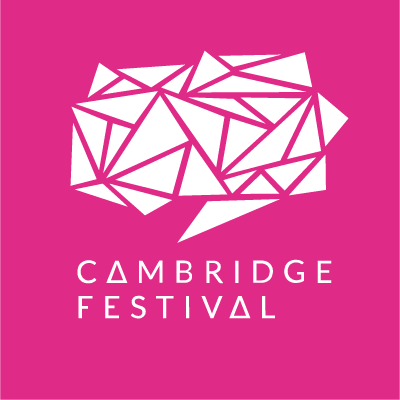
This is the online version of an exhibition held in the Old Library of St John's College, Cambridge on 9 April 2022 as part of the Cambridge Festival. It was our first public exhibition since the autumn of 2019. Owing to COVID concerns, we opted not for our usual approach of flinging the doors open for several hours and welcoming all comers, but for a series of timed, ticketed sessions. All 125 tickets were booked; a few people did not show up on the day, which allowed us to admit some who had been unable to book but came anyhow on the offchance.
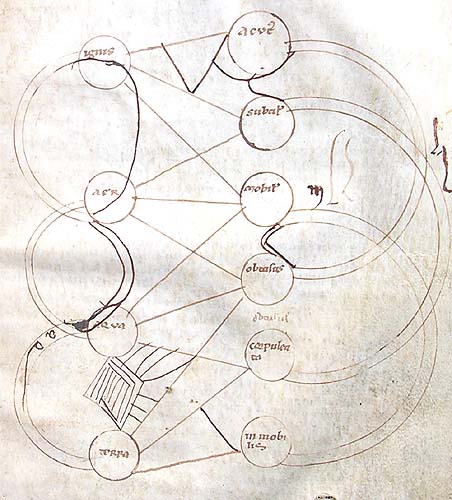
A version of Plato’s Timaeus, a discussion of the fundamentals of the physical world composed around 360 BC, is the final item in manuscript E.4, an 11th- to 13th-century miscellany. The volume incorporates an energetic (if not wholly self-explanatory) diagram illustrative of the connections and the distinctions between the four classical elements: fire (ignis), air (aer), water (aqua) and earth (terra). The elements have inspired the selection of items for this exhibition.
The first three concepts in the diagram’s second column are ‘sharp’ (acut[us]), ‘thin’ (subt[ilis]) and ‘mobile’ (mobil[is]), and the following three are ‘blunt’ (obtusus), ‘stout’ (corpulenta) and ‘immobile’ (inmobilis). Lines connect elements to the qualities they possess: air, for instance, is thin, mobile and blunt; only fire is sharp, and only earth immobile. Plato argues that fire and earth are the prime elements of creation, linked to each other, via the lesser two, by this chain of shared properties.
Robert Herrick (1591–1674) matriculated at St John’s at the age of 22; he later transferred to Trinity Hall because it was less expensive. He became a vicar in Devon, a post from which he was expelled for a time because of his Royalist sympathies during the English Civil War. His Hesperides (‘Daughters of the Evening’; A.2.80) contains over 1400 poems, many of them very short; ‘To the Virgins, to Make Much of Time’ is one of the better known (‘Gather ye rosebuds…’).
‘To Find God’, whose first line gives this exhibition its title, technically appears not in Hesperides but in the separately paginated His Noble Numbers, a selection of spiritual works. The poem’s thesis is nicely ambiguous: does it argue for the universality of a God who is present in the minutiae of the world’s elements, or for the impossibility of the human mind encompassing all that constitutes such a being? And if the latter, is awe or scepticism the appropriate response?
Ignis
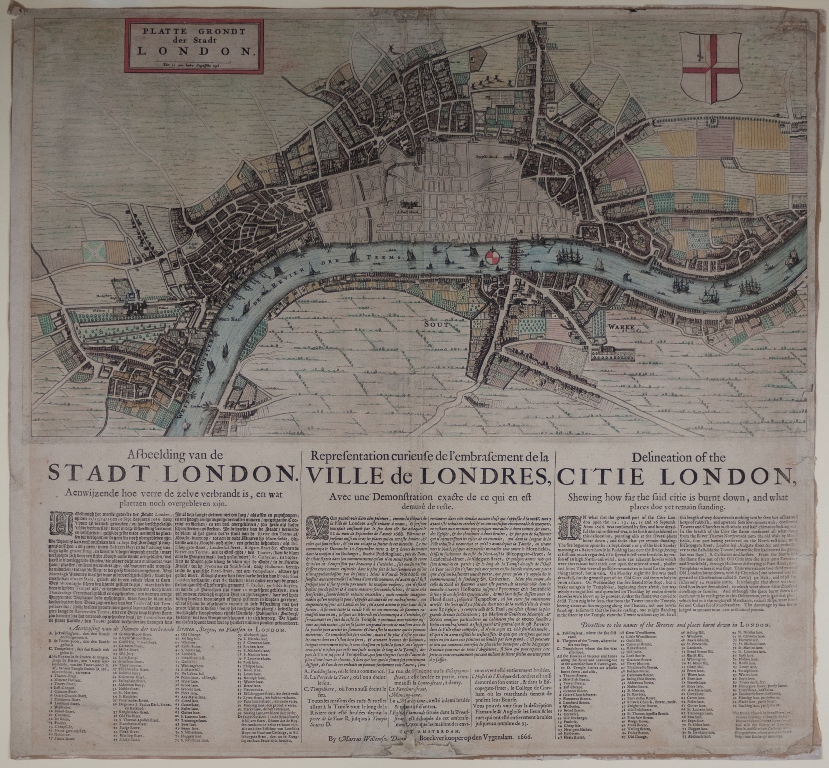
The Great Fire of London took place in the first few days of September 1666. That Marcus Willemsz Doornick (1633–1703), a Dutch mapmaker well known for his studies of Amsterdam, produced this map the same year shows that there was significant popular interest in the Fire, as does the explanatory text appearing in Dutch, French and English. The text describes the fire’s spread, the efforts to stop it, and the devastating effect it had on the most economically important area of the city.
The parts of London left standing after the blaze are depicted in the bird’s-eye view that was standard in maps of the time: looking closely, a viewer can see the windows and doors of buildings as well as their roofs. In contrast, the destroyed area appears as a set of outlines where buildings once stood; a few elements persist amid the blankness, such as the ruin of St Paul’s Cathedral, whose ribbed vault had been constructed, fatally, of wood rather than stone.
Henry Newcome (1627–1695), a clergyman and an alumnus of St John’s, kept this diary (MS N.29) while living a few miles away from Manchester. He accounts for contemporary events by transcribing his correspondence and that of others, alongside ‘private intelligence’. The page exhibited here includes Postmaster James Hicks’s account of the Great Fire of London, listing among the affected areas Queenhithe, Cannon St, Dowgate, Lombard St, Cornhill, the Temple, Holborn Bridge…
It hath pleased Almighty God to visit the famous city of London with a most rageing fire, wch began on Sunday morning last about 2 a clocke, in Puding Lane in a bakers house, behind the Kings head tavern in New fish-street: And though all meanes possible were used it could not be obstructed, but before night burnt all that part of the city […] And the last night & this day its run through all parts of this city […] and by all coniectures is not by any meanes to be stopt from a further ruining, except God in his infinite wisdom prevent.
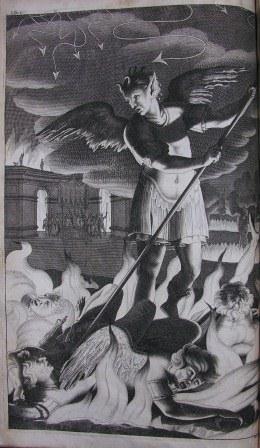
The 1688 fourth edition of Paradise Lost (Bb.3.5) was illustrated with engravings by Michael Burgher, at the behest of the canny publisher Jacob Tonson. John Milton’s epic, first published to poor sales in 1667, describes Satan’s rebellion against God and temptation of humankind. So sympathetic are Satan’s traits in comparison to God’s authority that he arguably emerges as the hero; William Blake suggested that Milton (1608–1674) was ‘of the Devil’s party without knowing it’.
Such place Eternal Justice had prepar’d
For those rebellious, here their Prison ordain’d
In utter darkness, and their portion set
As far remov’d from God and light of Heav’n
As from the Center thrice to th’ utmost Pole.
O how unlike the place from whence they fell!
There the companions of his fall, o’erwhelm’d
With Floods and Whirlwinds of tempestuous fire,
He soon discerns…
Actes and Monuments, better known as the Book of Martyrs, is a study by John Foxe (1516/17–1587) of Christian martyrs that devotes much of its considerable length to the suffering of English Protestants under Catholicism. Not above sacrificing historical accuracy in the name of polemic force, Foxe nonetheless incorporated his opponents’ criticisms – or his rejections thereof – into future editions, pushing the length far beyond the 1800 pages of this 1563 first edition (Aa.4.37).
Pictured is the martyrdom of Thomas Cranmer, Archbishop of Canterbury during the reigns of Henry VIII and Edward VI. When Mary I, a Catholic, took the throne, Cranmer was imprisoned on charges of treason and heresy, and eventually executed in Oxford despite his supposed rejection of Protestantism; as represented in the woodcut illustration, Cranmer ensured that the hand with which he had signed his recantations was the first part of him to burn.

Nathaniel Nye (born c. 1624) was a mathematician and cartographer with a keen interest in guns. He is recorded as being involved in cannon testing in his hometown of Birmingham in 1643 and 1645, and he went on to direct the parliamentary artillery at 1646’s Siege of Worcester during the English Civil War. He channelled these experiences into 1647's The Art of Gunnery (Ff.13.44), ‘composed for the help of all […] that have charge of Artillery, and are not well versed in Arithmetick and Geometry’.
The book is primarily a military treatise, concerning quantities of gunpowder, weights of projectiles, and questions of distance and height and angle. But after a treatise on ‘Artificial Fire-Works for the Wars’ – flaming arrows; grenades – Nye offers a concluding discussion of recreational fireworks. Assuring the reader that his guidance is based on personal experience, he advises on fire-wheels, fizgigs and, as displayed here, rockets whose explosions produce different shapes.
Aer
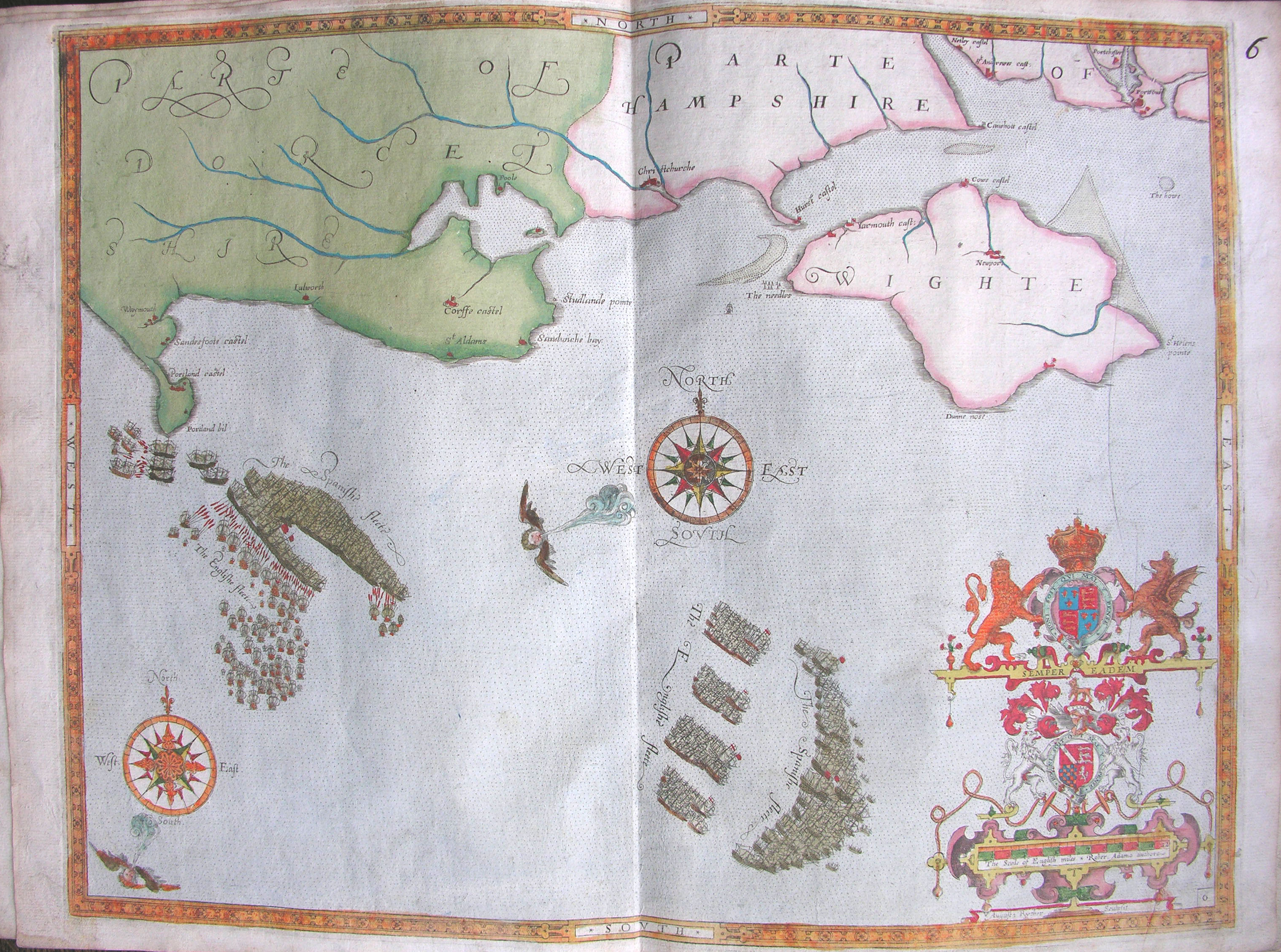
In 1588, King Philip II of Spain dispatched a fleet of one hundred and thirty ships – the Spanish Armada – to England, in an attempt to depose Elizabeth I from the throne. A combination of English naval strategy and stormy weather led to the failure of the enterprise; within two years of Spain’s defeat, the architect Robert Adams and the engraver Augustine Ryder had produced this volume of maps, Expeditionis Hispanorum in Anglia Vera Descriptio (Aa.5.5), charting the details of the conflict. It was a commercial success.
A pictorial account of naval manoeuvres might reasonably have been linked to aqua rather than to aer, but wind is a significant factor in the sailing of ships, and among the many charms of Adams’s maps are the puffing faces that indicate the wind’s direction at different stages of the conflict. Medals produced to commemorate the victory – of, in part, Protestantism over Catholicism – bore the legend ‘God blew and they were scattered’ or variations thereon.
William Wordsworth (1770–1850) studied at Cambridge, coming up in 1787. As he puts it in his autobiographical poem The Prelude, ‘The Evangelist St John my patron was’: that is, he was a student at St John’s, where ‘All winter long, whenever free to choose, | Did I by night frequent the college groves | And tributary walks’. His portrait hangs in the College’s dining hall; the Old Library's collections include his life mask.
Wordsworth said that poetry was the consequence of ‘emotion recollected in tranquility’, and this is a useful reference point when reading his sonnet ‘Composed During a Storm’, a poem that might initially seem to offer only simplistic comfort. Tranquility does not banish, and need not be banished by, turmoil: they coexist, and define each other’s boundaries. And providential goodness is ‘ever nigh’, always near: the hoped-for never quite arrives, although it can be glimpsed. This image of the poem is taken from an 1858 edition of Wordsworth's Poetical Works (W.a.1858.3).
Samuel Butler (1835–1902) studied Classics at St John’s in the 1850s. A lifelong polymath, he devoted his energies variously to painting, novels, literary criticism, autobiography and sheep-farming. He was also a pioneer of snapshot photography, and the Library holds several albums of his pictures as well as the original glass-plate negatives. Displayed here are images taken in the Netherlands, 15–18 April 1892, among their subjects windmills at Hoorn and Zamdam (Butler/IX/Albums/2).
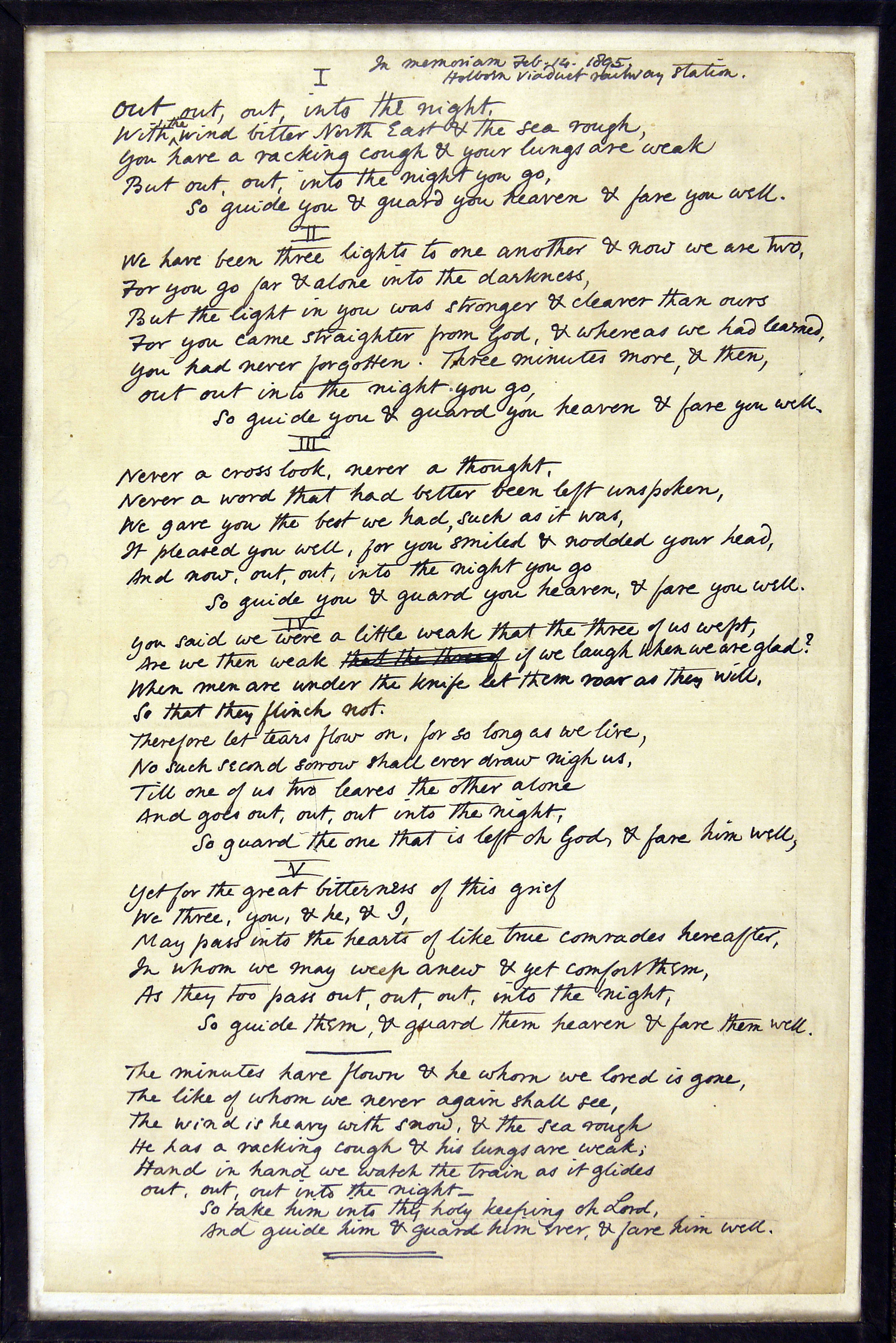
Butler’s 1895 ‘In Memoriam’ poem (Butler/II/10/1) is for Hans Rudolph Faesch, and such is its expression of ‘every loving and affectionate thought which one man can think about another’ that he was wary of publication. The dedicatee questioned the poem’s prayerful quality; Butler called prayer ‘nonsense’, yet insisted: ‘I know no words that express a very deeply held hope so well as those I have used, and the fact that others make money from prostituting them shall not stop me from using them.’
The naturalist and wood-engraver Thomas Bewick (1753–1828) is best known for this work, which divides the country’s bird population into ‘land’ and ‘water’ birds across two volumes. Its elegant illustrations and descriptions range, in the words of Charlotte Brontë (whose father, Patrick, was a Johnian), ‘From the great eagle, with his lightning eye, | His tyrant glance, his talons dyed in blood, | To the sweet breather-forth of melody, | The gentle merry minstrel of the wood.’
The Library’s edition of Bewick is a 1797 first edition (8/W.5.44), which unfortunately means no representation of the peregrine falcons that occasionally strew other birds’ feathers around Chapel Court: Bewick did not include the peregrine until a later edition. One must, then, settle for that ‘great eagle’, one of the Beasts of the Apocalypse and the emblem of St John the Evangelist and of St John’s. The golden eagle was wiped out in England in the decades following Bewick’s book.
Aqua
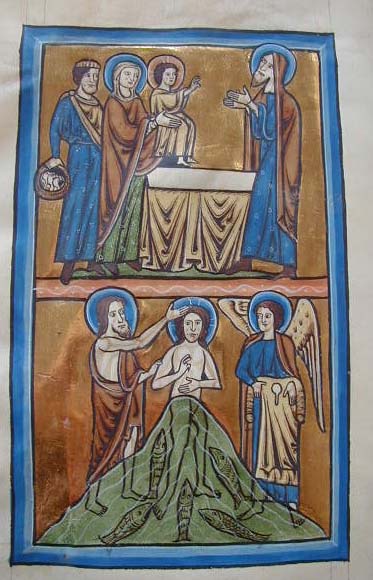
The book of psalms included in this 13th-century volume (MS D.6) is preceded by several full-page images depicting scenes from the life of Christ. Here, two scenes of ritual are paralleled: on top, the infant Christ is presented to Simeon in the Temple, and below the adult Christ is baptised by John. In the account given in Matthew 3, John resists, saying ‘I have need to be baptised of thee, and comest thou to me?’; Jesus insists on the importance of ritual, of ‘fulfil[ling] all righteousness’.
M.R. James, best known today for his ghost stories, was a medievalist who published a catalogue of the College’s manuscripts in 1913. He describes Christ, in this image, as standing ‘in a heap of water with fishes in it’. The fish might signify Christ’s followers, sharing in his baptism. Meanwhile, the angel on the right holds the seamless robe in which Christ will be crucified; the ‘heap’ of water, therefore, could suggest the hill of Golgotha/Calvary, site of the crucifixion.
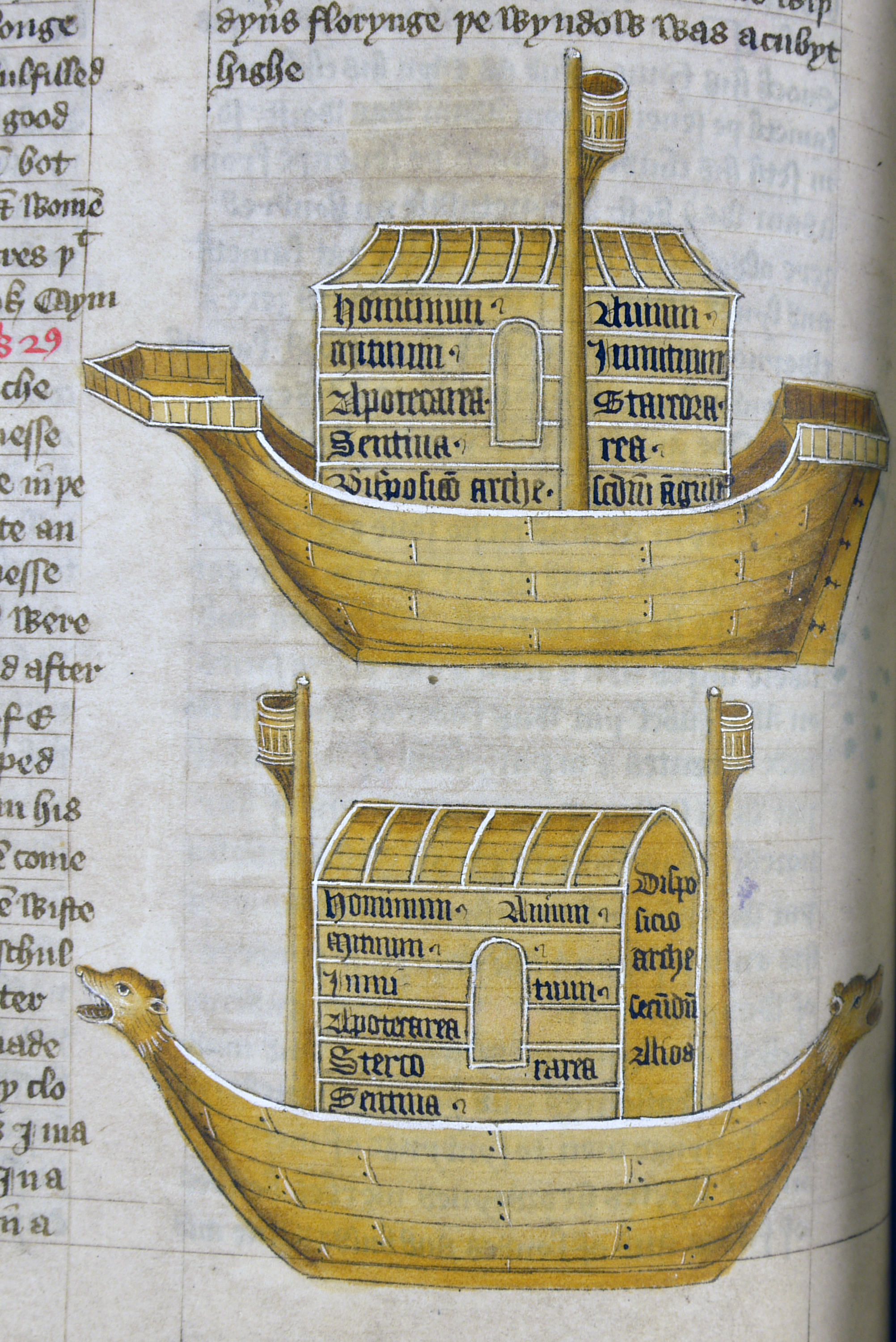
This manuscript (MS H.1) is from the late 14th century. It contains several English translations by John Trevisa (1342–1402), including Ranulph Higden’s Latin Polychronicon, a world history. Like Schedel’s Liber Chronicarum (also in this exhibition), the Polychronicon’s version of history is heavily influenced by the Bible, not only in its seven-part structure (a reference to the seven days of creation in Genesis) but also in its inclusion of such events as the Flood, where water destroys life as well as sustaining it.
Displayed here are two illustrations of Noah’s Ark, one based on descriptions by Augustine (Disposicio arche secundum Augustinus) and one on the work of others (Disposicio arche secundum alios): Genesis 6 gives some measurements but not the precise arrangement. In both diagrams, the floors of the Ark are devoted to humans (hominum), birds (avium), tame animals (mitium), wild animals (inmitium), store rooms (apotocarea), privies (stercorarea), and the hold (sentina).
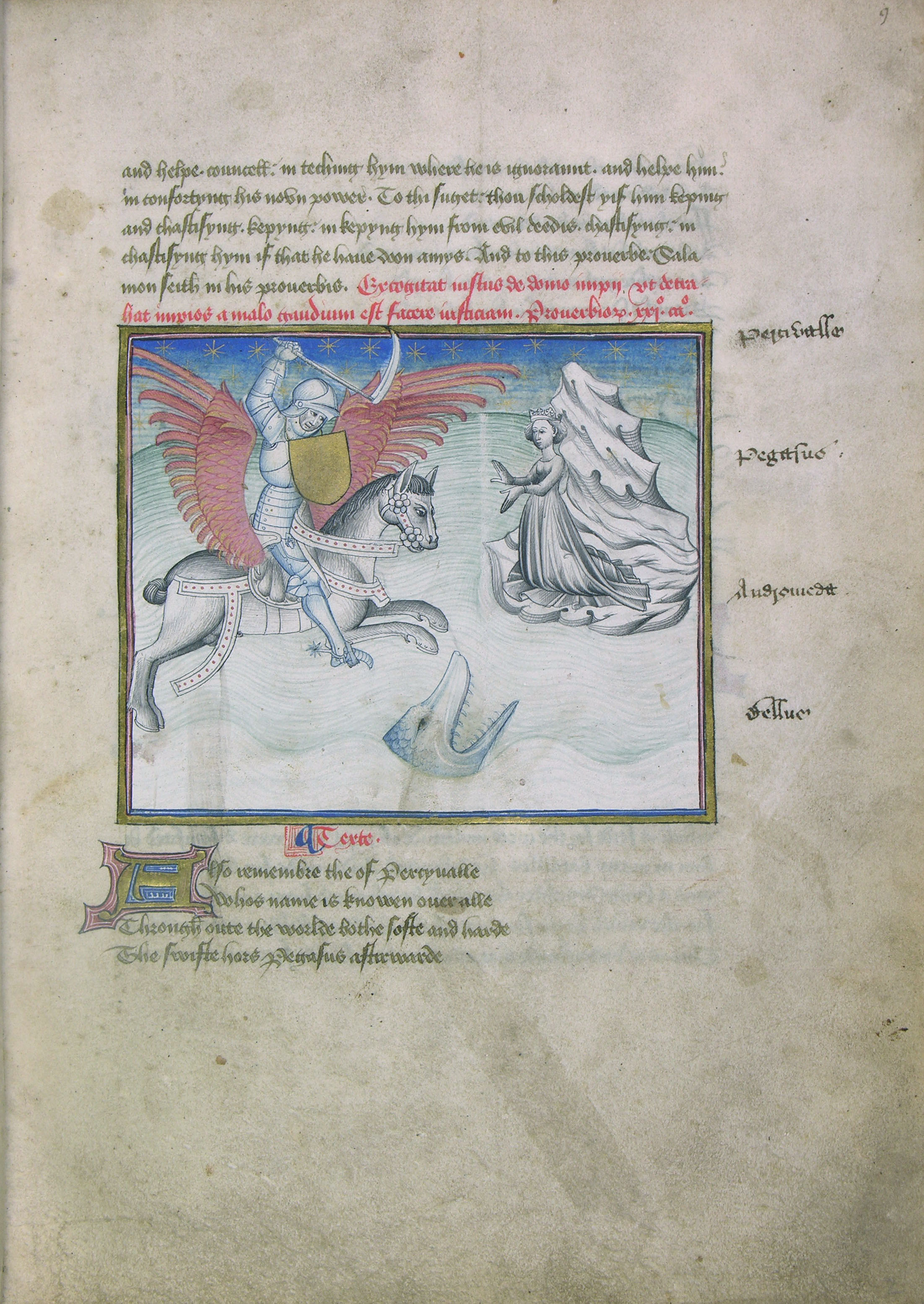
L’Epistre Othéa is a text by the Italian poet Christine de Pisan (1364–c. 1430), who served as a court writer in France under Charles VI. The text imagines Othea, goddess of wisdom, writing in verse and prose to the Trojan war hero Hector to educate him, by way of analogies drawn with mythic narratives, on matters of statecraft. The Library’s manuscript (MS H.5) is a 15th-century English translation produced by Stephen Scrope for the Duke of Buckingham.
Displayed here is an image of the Greek hero Perseus, mounted on the flying horse Pegasus, rescuing Andromeda from a sea monster, ‘the which by the sentence of the godes shulde a deuoured hire’. Othea uses this as an example of the chivalry expected of a knight: ‘alle knyghtes shulde socoure women that had nede of there socoure […] Andromeda that shal be delyuered, it is his sowle, the which he delyueres from the feende of hell by the ouercomyng off synne.’
Everard Digby (born c. 1550) was a student at St John’s and went on to become a Fellow; he was eventually expelled, however, on the grounds of his Catholic sympathies, his tendency to halloo and blow a horn around the College during the day, and his habit of speaking ill of the Master. Shortly before his expulsion, he published a Latin swimming manual; the Library’s copy (Aa.6.19) was given to the College by the antiquarian Thomas Baker, another ‘Collegii Socius ejectus’.
De Arte Natandi combines discourse on the philosophy of the sport with practical guidance on the performance of specific strokes. The strokes are illustrated via full-page woodcuts, adding much appeal to what could otherwise have been, as it were, a dry book. Depictions of swimmers performing the strokes are inserted into larger images of riverside activity; the windmill and the voyeuristic, anthropomorphised sun appear several times in the volume.
Terra
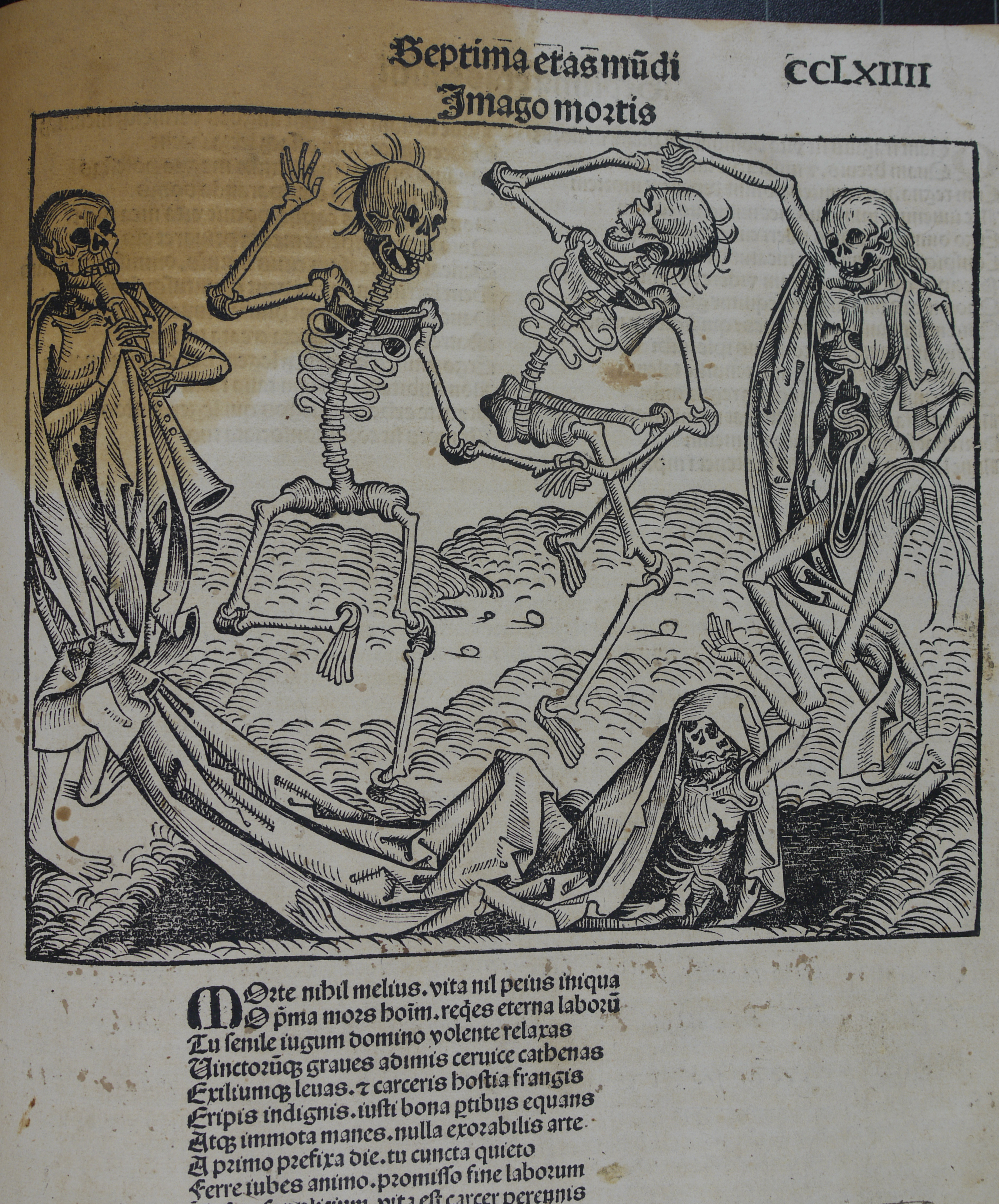
The Liber Chronicarum (Ii.2.26), also known as the Nuremberg Chronicle, is Hartmann Schedel's 1493 Biblically-inflected world history that also looks ahead to the end times. Lavishly illustrated with woodcuts by Michael Wolgemut, the book reuses many of its images, such that some of the towns and monarchs it depicts are distinguished only by their labels. This makes the unique images additionally striking, not least the unsettling portrayal, towards the book’s conclusion, of the Dance of Death.
The Dance of Death (or Danse Macabre, or Totentanz) is a reminder that death comes to all, whether individually or en masse. Threatening, or blackly comic, as the depiction in the Liber Chronicarum is, the accompanying poem adapted from Petrarch praises death for being a sure relief from the sufferings of the flesh; death is ‘immota’, an immovable certainty, chiming with the Platonic conception of earth (from which these skeletons rise) as the one immobile element.
Erasmus Darwin, grandfather of Charles, studied at St John’s in the 1750s. A physician, an inventor, a supporter of women’s education, a proponent of maternal breastfeeding and a campaigner against slavery, Darwin was also a poet and a student of evolution. The Botanic Garden, first published in 1791 and held by the Library in an 1824 edition (Mm.5.49(1)), combines close academic observations and mythopoeic flourishes in a pioneering and much-reprinted work of popular science, one that holds plants and humans in close comparison.
On Dionaea muscipula, the Venus flytrap, pictured:
Haste, glittering nations, tenants of the air,
Oh, steer from hence your viewless course afar!
If with soft words, sweet blushes, nods, and smiles,
The three dread Syrens lure you to their toils,
Limed by their art in vain you point your stings,
In vain the efforts of your whirring wings!—
Go, seek your gilded mates and infant hives,
Nor taste the honey purchas’d with your lives!
The physician William Heberden (1710-1801), a Fellow of St John’s, delivered a series of lectures in the 1740s on materia medica, substances once believed to have medicinal properties. Heberden’s subject was the history, not the contemporary practice, of medicine, such that he was reporting the claims rather than necessarily supporting them; he illustrated his lectures with physical specimens, and later donated them, and their cabinet, to the Library.
Displayed here, along with an annotated lecture list, is drawer 17, one of several drawers devoted to mineral products. Among the items included are the star-shaped fossil asteria (believed to help with urinary tract stones), shards of lapis specularis (used by the Romans to make windowpanes, and in powdered form for therapeutic purposes), and lapis de Goa (a gilded combination of hair, shells, resin and other items, made by Jesuits in India and shaved into beverages to counteract poison).
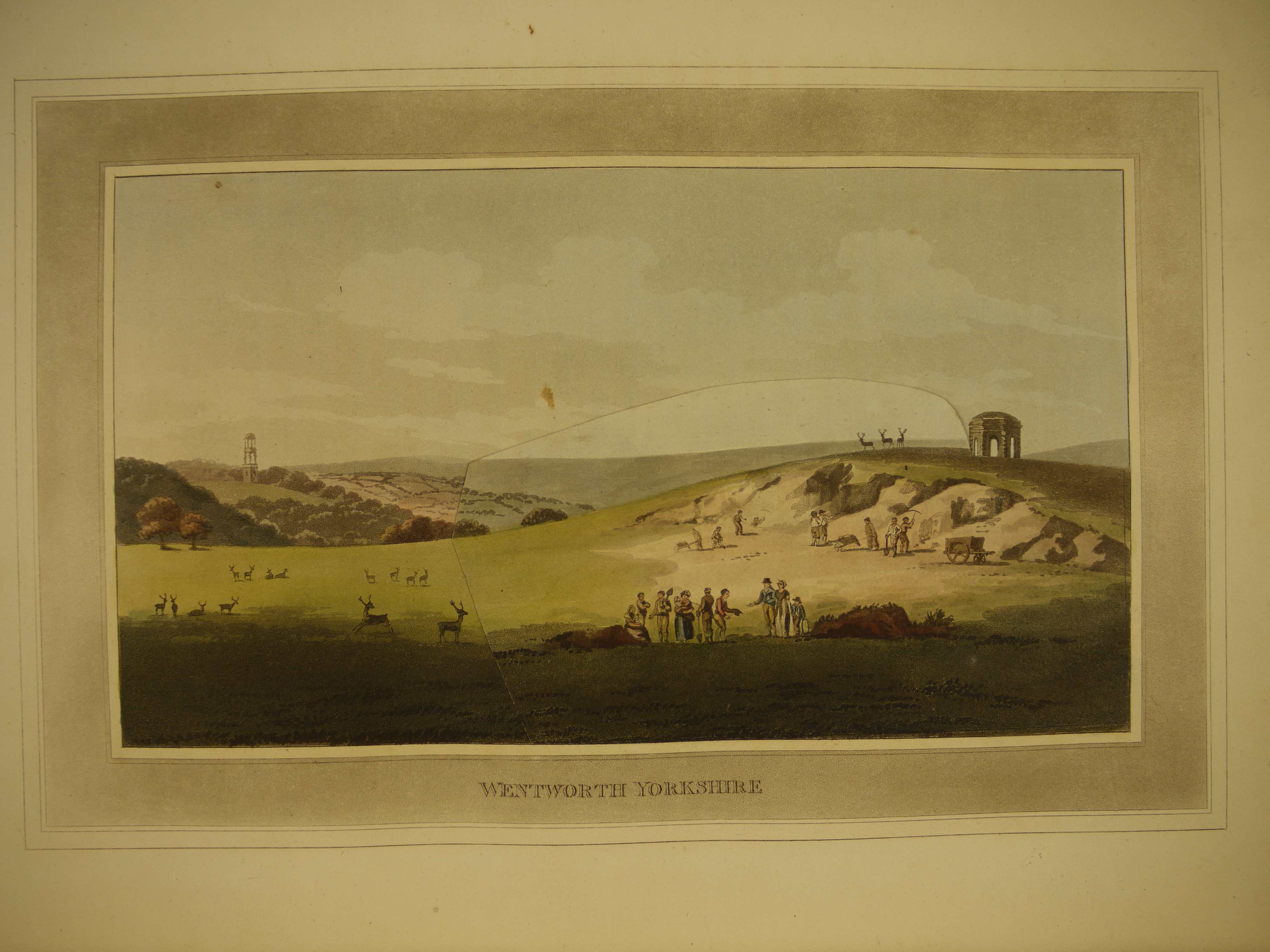
Humphry Repton (1752–1818), inspired by ‘Capability’ Brown (head gardener of Hampton Court), coined the term ‘landscape gardener’ to refer to his practice. He advocated for the highlighting of a landscape’s ‘natural beauties’; for enhancing ‘the appearance of extent and freedom by carefully disguising or hiding the boundary’; for ‘studiously conceal[ing] every evidence of art’; and for the removal or concealment of ‘all objects of mere convenience or comfort’.
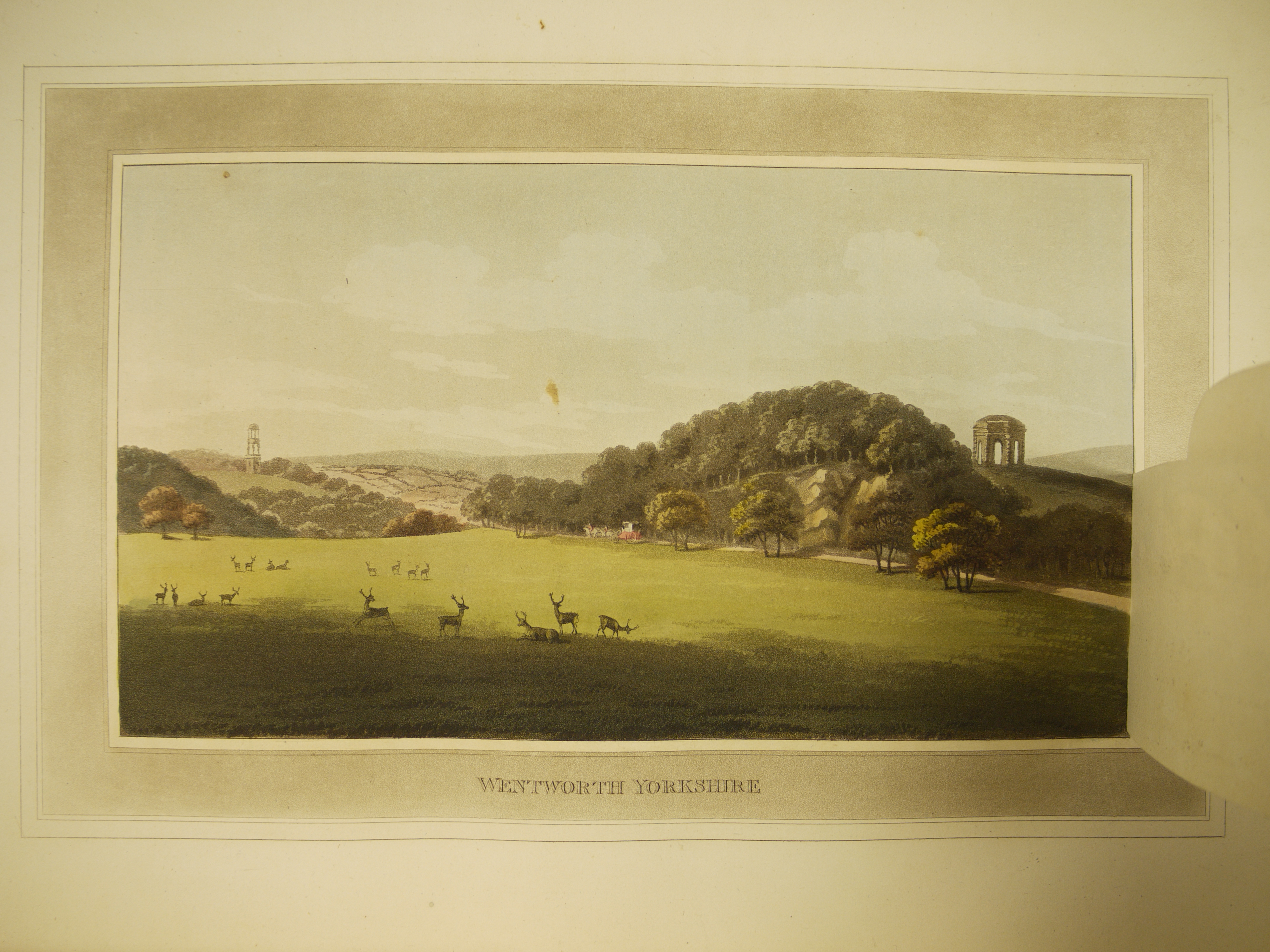
Repton had relatively little involvement in the practical work associated with resculpting landscapes, and many of his designs did not come to fruition. Still, the ‘Red Books’ he produced to explain his proposals to his clients – containing watercolours and manuscript explanations – were (and are) valued as art objects for their own sake; they often include, as does this printed volume (1805's Observations on the Theory and Practice of Landscape Gardening, Ga.18b.3) , flaps that can be lifted to reveal the proposed improvements to each site.
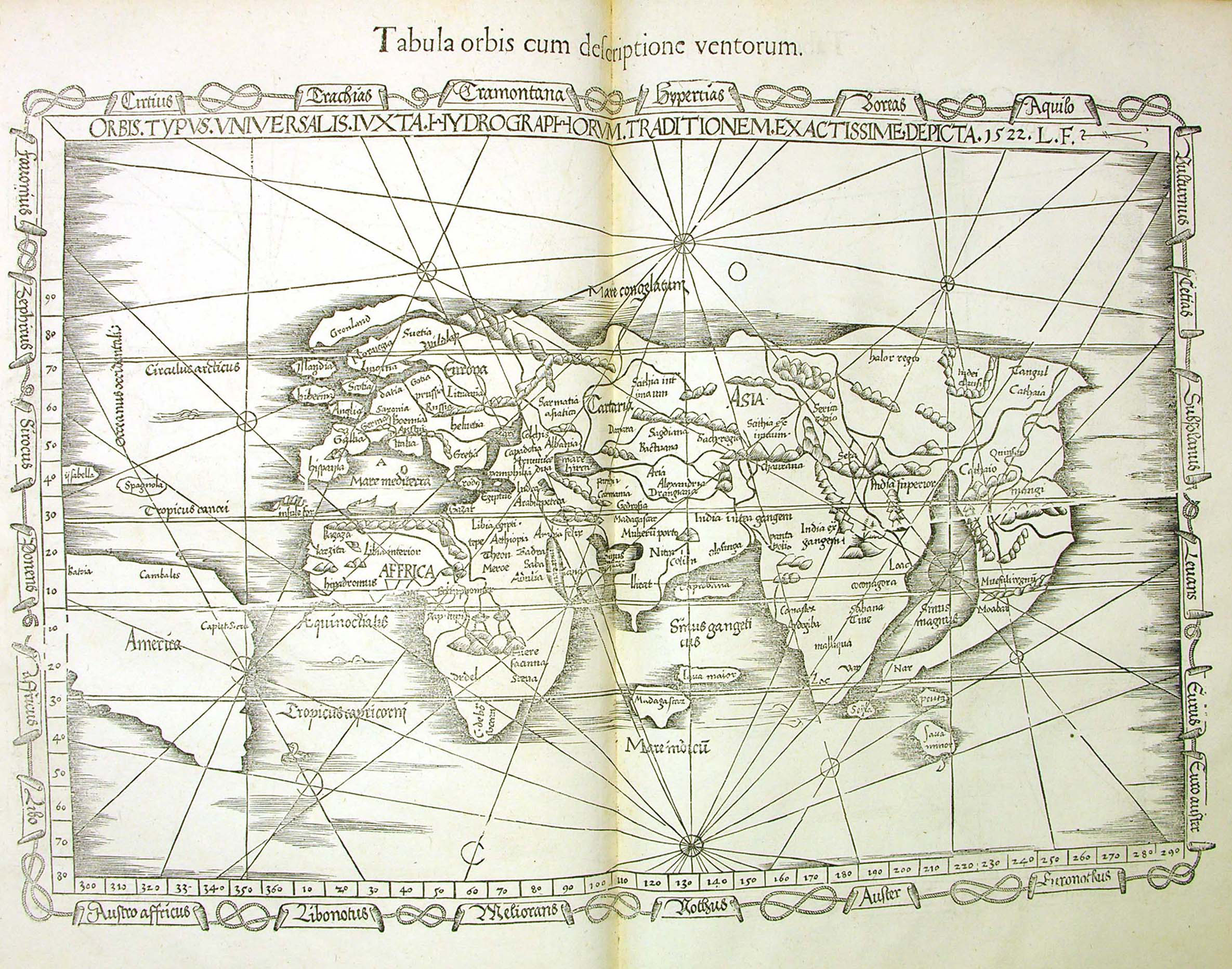
The Greek mathematician and astronomer Ptolemy (c. 100–c. 170) wrote the Geographia (D.6.34) not only as an atlas (a term that would not be adopted until the 16th century by Gerardus Mercator) but also as a guide to the principles and practice of map-making. He was well aware that he and his European contemporaries had a limited knowledge of the globe; over the centuries, cartographers gradually refined his sense of the shape of the planet and how to represent it.
This 1541 volume’s maps are from a 1522 edition by Laurent Fries, including a world map: based on a wall map by Martin Waldseemüller, it was the first atlas map to use the name ‘America’. Also notable, with respect to this exhibition’s theme, is that this depiction of the earth includes, alongside land and sea, a frame incorporating the names of the winds, while the interlocking directional lines evoke the chart of elemental qualities included in the Plato manuscript with which the exhibition opened.